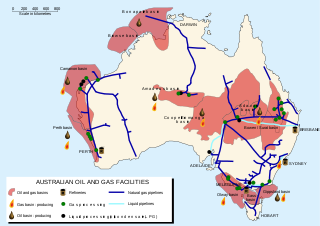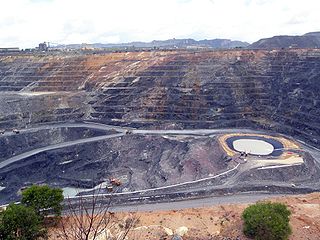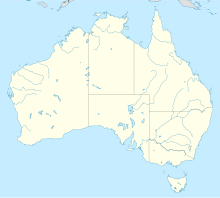
The Hunter River is a major river in New South Wales, Australia. The Hunter River rises in the Liverpool Range and flows generally south and then east, reaching the Tasman Sea at Newcastle, the second largest city in New South Wales and a major harbour port. Its lower reaches form an open and trained mature wave dominated barrier estuary.

Gunnedah is a town in north-eastern New South Wales, Australia and is the seat of the Gunnedah Shire local government area. In the 2016 census the town recorded a population of 9,726. Gunnedah is situated within the Liverpool Plains, a fertile agricultural region, with 80% of the surrounding shire area devoted to farming. The Namoi River flows west then north-west through the town providing water beneficial to agricultural operations in the area.

Leigh Creek is a former coal-mining town in eastern central South Australia. At the 2016 census, Leigh Creek had a population of 245, a 55% decrease from 550 in the previous census in 2011.

Xstrata plc was an Anglo-Swiss multinational mining company headquartered in Zug, Switzerland and with its registered office in London, United Kingdom. It was a major producer of coal, copper, nickel, primary vanadium and zinc and the world's largest producer of ferrochrome. It had operations in 19 countries across Africa, Asia, Australasia, Europe, North America and South America.
The Australian Agricultural Company (AACo) is a public-listed Australian company that, as at 2018, owned and operated feedlots and farms covering around seven million hectares of land in Queensland and the Northern Territory, roughly one percent of Australia's land mass. As of July 2008 AACo had a staff of 500 and operated 24 cattle stations and two feedlots, consisting of over 565,000 beef cattle.

Mining in Australia has long been a significant primary sector industry and contributor to the Australian economy by providing export income, royalty payments and employment. Historically, mining booms have also encouraged population growth via immigration to Australia, particularly the gold rushes of the 1850s. Many different ores, gems and minerals have been mined in the past and a wide variety are still mined throughout the country.

Coal is mined in every state of Australia. The largest black coal resources occur mainly in Queensland and New South Wales. About 70% of coal mined in Australia is exported, mostly to eastern Asia, and of the balance most is used in electricity generation. Coal production in Australia increased 13.6% between 2005 and 2010 and 5.3% between 2009 and 2010. In 2016, Australia was the biggest net exporter of coal, with 32% of global exports, and was the fourth-highest producer with 6.9% of global production. 77% of production was exported. In 2019-20 Australia exported 390 Mt of coal as was the world's largest exporter of metallurgical coal and second largest exporter of thermal coal.

The energy policy of Australia is subject to the regulatory and fiscal influence of all three levels of government in Australia, although only the State and Federal levels determine policy for primary industries such as coal.
The Anvil Hill Coal Mine is proposed for the upper Hunter Valley in New South Wales. There is strong support for and against the coal mine within the Hunter Valley and other areas. The coal mine will be managed by Centennial Coal with Mines operator expected to be Thiess. The mine will provide coal mostly for the production of electricity. It currently has contracts for providing coal to Bayswater / Liddell power stations in the Upper Hunter for 12 years, commencing in 2008.
The Wallarah 2 Coal Project is a proposal by the Korea Resources Corporation or KORES to construct a longwall mine near Wyong, New South Wales, Australia. The mine is now being considered by the NSW Department of Planning. It was previously rejected by the Keneally Government shortly before the 2011 State election.
Shenhua Group Corporation Limited was a Chinese state-owned mining and energy company. Shenhua Group was founded in October 1995 under the auspices of the State Council of the People's Republic of China. It was the largest coal-producing company in China. In 2014 Shenhua Group produced 437 million tonnes of coal and sold 588 million tonnes of coal. In 2014, Shenhua Group's revenue was 328.6 billion yuan, and the company ranked 196th in the Global Fortune 500. The same year the Shenhua Group's profit was 64 billion yuan. On August 28, 2017, SASAC announced that China Guodian Corporation and Shenhua Group will be jointly restructured, with Shenhua Group becoming China Energy Investment Corporation and absorbing China Guodian Corporation.

Banpu Public Company Limited is an energy company based in Thailand. Its three core businesses are energy resources ; energy generation ; and energy technology. As of 2015 Banpu is headed by CEO Somruedee Chaimongkol. In the 2012 Forbes Global 2000, Banpu was ranked as the 1707th -largest public company in the world.

The prospect of nuclear power in Australia has been a topic of public debate since the 1950s. Australia has never had a nuclear power station. Australia hosts 33% of the world's uranium deposits and is the world's third largest producer of uranium after Kazakhstan and Canada.
Environmental Defenders Office (EDO) is an Australian law centre that encourages and enables litigation, law reform, and community engagement on environmental issues. EDO formed in late 2019 with the merger of eight separate state and territory organisations into one national organisation. Topics of interest to EDO include: climate change, biodiversity, water, and healthy communities.
The Environmental Defender's Office (NSW) in Sydney, New South Wales, was one of nine EDO offices located across Australia, formerly known as the Australian Network of EDOs (ANEDO).

Mining in the United Kingdom produces a wide variety of fossil fuels, metals, and industrial minerals due to its complex geology. In 2013, there were over 2,000 active mines, quarries, and offshore drilling sites on the continental land mass of the United Kingdom producing £34bn of minerals and employing 36,000 people.

Radioactive ores were first extracted in South Australia at Radium Hill in 1906 and Mount Painter in 1911. 2,000 tons of ore were treated to recover radium for medical use. Several hundred kilograms of uranium were also produced for use in ceramic glazes.
÷Some of the more notable coal companies in Australia are the following:

The Carmichael coal mine is an under-construction 10 million-tonne per annum open-pit thermal coal mine in the north of the Galilee Basin in Central Queensland, Australia owned by Bravus Mining & Resources, formerly known as Adani Australia. It struck first coal in June 2021. The open-pit mine was approved by the Queensland Government and the federal Australian governments. The development was initially intended to represent an A$16.5 billion investment; however, Adani announced in 2018 that the mining operation would be significantly downsized from 60 to under 10 million tonnes per year and self-funded to A$2bn.
The following lists events that happened during 2016 in Australia.












